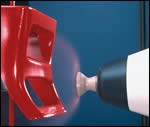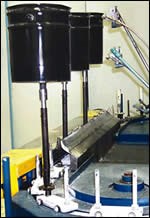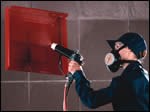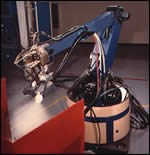Automation: To What Degree?
Webster has three definitions for automation, but the second one applies best to painting: “The techniques and equipment used to bring about automatic operation and control.” Within that statement, techniques and equipment become the operative words because there is such a broad range and degree of both.
Webster has three definitions for automation, but the second one applies best to painting:
“The techniques and equipment used to bring about automatic operation and control.” Within that statement, techniques and equipment become the operative words because there is such a broad range and degree of both. Without automation and in its simplest form, there might be some kind of product conveyance using a hand sprayer located in a ventilated spray booth. There would also be the attendant paint mixing and handling. With a painter experienced in all phases of the process and a rotatable hanger for the parts, practically anything within reasonable boundaries of size can be painted without special instructions, equipment or attention. To the casual observer, this appears to be an incredibly simple process. However, many steps must be taken to render an acceptably painted product:
- Paint is received in-house, color- matched, agitated and solvent-blended to the right viscosity.
- Mixed paint is moved from the paint kitchen and loaded into the equipment.
- Mixed paint is delivered to the spray gun at the proper rate for acceptable application.
- The spray gun is moved through whatever paths, and at the proper speed, to coat a specific object.
- Specific objects are identified by the operator and the spray gun is moved accordingly.
- Objects to be painted may be rotated on the conveyor or moved about slightly to facilitate application of the paint into shielded areas.
- Any number of different objects may be totally intermixed on the conveyor without a problem.
These operations may be performed by a single skilled operator with only rudimentary spray and fluid-handling equipment. With the spray booth, air replacement, oven and conveyor as a given, the annual cost for the operator is under $40,000. Consider the measures required for totally automating this simple process, and virtually eliminating the human element.
Paint
Some arrangement must be made with the paint supplier to ensure that different batches of paint match from a color viewpoint. It must also arrive in-house at some predetermined viscosity at a given temperature. Assuming these parameters can be arranged, unskilled labor can transfer the paint from the shipping containers and load it into a pumping station for delivery to the spray booth. This station will have agitation, a preset pumping pressure, filtration, viscosity, temperature control and associated plumbing runs. If several colors are involved, there must be identical stations for each color.
At the spray booth, there must be a series of valves that allows the paint to circulate in the system. These valves must also be opened automatically when a specific color is being processed. Circulation is mandatory even if there is no pigmentation that could settle out. This valving manifold must also be designed so that at the end of a particular color run, solvent and air can be introduced to scrub clean all the wetted surfaces in the system, preparing them for introduction of the next color.
Regardless of the paint-application device, paint pressure must be regulated downward from the circulation pressures in the system. Flow metering, coupled with a feedback system, is required to operate the regulators to a preset for any given color or product to be painted. If air atomization is employed, these pressures must also be controlled with transducers and feedback to maintain presets for specific parts and colors.
Machinery
There are a number of machines designed for movement of the paint-application device, but if the goal is to emulate a live experienced painter, the requirement dictates a six axis, programmable robotic arm. These precision units can duplicate nearly any movement required for any given painting process.
Control
This portion of the automation will be to sense conditions for paint application to the product. Depending on factory production requirements, every different part to be painted could require a different color.
At some stage, this information is loaded into the controller. Through some identifying scheme, the controller recognizes widget “Q” from other objects and initiates a color change, selects the new color, identifies the spray path program, tracks widget “Q”s movement and triggers the painting process.
The approximate cost for this automation including a six-color paint kitchen is $535,000. Given today’s business climate, it would be rare to find anyone willing to make such an investment without realizing a particular benefit — except, possibly, for the repeatability gained through robotics.
A more logical scenario is where, over time, a myriad of equipment purchases, booths, spray operators and set-up people have been added, only to find a cap on the achievable production rate. At this point, some organized automation makes sense.
Automation Techniques
A vertical or horizontal array of stationary guns (of any type) can be quite useful in automating a line. This is particularly true where large areas must be coated and the finish does not need to be extremely fine. Products can move past the gun array either horizontally or vertically, depending on the conveyor system involved. The gun set-up can be time consuming because of optimizing spray pattern overlap for uniformity. Once arranged, however, high conveyor speeds can be achieved, which can produce much more product.
Another application with stationary guns is the coating of tubular products as they exit a fabricating process. Directing two or three fan-spray guns at the diameter of the fabrication will readily allow application of protective films, oils and die lubricants.
The advantage of using stationary guns lies in the simplicity of their arrangement. There are no moving, flexing hoses, no mechanisms to lubricate, no dirt droppings as a result of the machinery, and most importantly, this is probably the least expensive approach to automating.
Transverse machines or long-stroke reciprocators, are designed to move a fan-spray gun, or array of guns, up and down or back and forth in a straight line. Machine stroke, of course, is a function of product height or width. Not so obvious is the requirement of the gun to travel 8-12 inches beyond either edge of the part. When the machine changes direction, the carriage stops momentarily. If the guns were still spraying on the part during that time, the finish would be ruined.
Vertically hung products that have varying lengths can all be coated with the same machine. Essentially, the machine is designed to operate with the longest part. During operation with shorter work, the guns physically move through the design stroke, but only trigger on as they pass through the work piece length.
Many machine applications use two machines, one on either side of the conveyor line for straight-through operations. This is usually done where the work is more than several feet in length horizontally. If the work is shorter, indexing 90° between machines permits spraying from one side of the conveyor only. The advantage here is the requirement of only a single spray booth.
Machine construction and design will vary depending on duty requirements and cost considerations. However, all involve a carriage moving on a section of tracks, rails or a tube of given length. This carriage can be moved in several different ways.
One method is a continuously moving chain, which is supported by sprockets at either end of the machine support frame. With a vertical machine, the lower sprocket is motor driven at the desired speed. Attached to one side of the chain is a sealed roller bearing that rides between a pair of vertical gibs or metal blocks on the carriage. This arrangement pulls the carriage along the straight-line travel. As the bearing goes around the sprocket at either end of the machine, the carriage comes to a halt and the bearing changes position between the gibs. Actually, the carriage decelerates to zero, and then accelerates to gun speed in the time it takes for the bearing to travel the 180° around the end sprockets. This mechanism is called a “scotch crosshead.”
There are several power options for use with machines employing crosshead mechanisms. A continuously running, single-speed electric motor with a variable-speed belt-reduction system driving one of the sprockets is the least expensive. More expensive, although more versatile, are gear reduction drives with variable-speed motors.
Machines that do not employ the crosshead can be driven by direction-reversing DC motors with built-in programmable controllers. These machines can move in one direction faster than in the other, or change speed during travel in either direction. They can also be programmed for a number of selectable stroke lengths. These machines are frequently referred to as “smart” reciprocators.
With transverse machines, either vertical or horizontal, the work moves at right angles to the machine stroke. As a result, the strip of paint applied to the work with a single gun is never in a straight line. It is always angled to the left or right depending on which way the conveyor is moving. The angle is a function of conveyor speed as related to machine speed. To obtain a continuous coating, the spray patterns must overlap approximately 50%. On a vertical machine carrying a single spray gun with a 10-inch wide pattern, the machine or gun speed must be about 10 times that of the conveyor. If two guns were mounted and spaced so that their fixed spray patterns overlap by 20 inches, the machine speed could be reduced to about five times the conveyor speed. Similarly, three guns would reduce machine speed to a third. Most long stroke machines are mechanically limited to approximately 250 ft per minute (FPM) and a specific carriage load which depends on machine construction.
The relationship between machine cycles (FPM divided by chain length) and conveyor speed is given by:
Cycles x Spray Pattern Width = Conveyor F.P.M.
Besides DC motor drives, there are other machine movement options that do not require a crosshead. Rotary hydraulic motors are used, which are reversed at the top and bottom of the stroke. Control cams for the hydraulic actuators permit selection of several preset stroke lengths. Work has also been done with air-actuated long-stroke cylinders. Pneumatic and hydraulic power options avoid the expense of explosion-proof motor housings and wiring required with electric versions.
Spray guns on a long-stroke machine need not be positioned at a fixed distance from the work. Where part width varies perpendicular to the conveyor, the machine can be automatically moved to maintain proper gun-to-work distance. In many instances it is desirable to follow a long-radius, somewhat circular surface, such as the side of an automobile. In “contour” machines of this nature, the gun array is attached to the vertically moving carriage with a sliding arm mechanism. This permits horizontal movement of the guns with respect to the painting surface. A swivel joint is included, allowing the guns to be tilted approximately 30 degrees up or down. Guide rollers attached to the gun array ride a cam surface that is shaped like the surface to be sprayed. As the carriage moves in a straight line up and down, the guns follow the cam. The guns contour and swivel to keep the guns perpendicular to the work surface.
There are several long-stroke techniques employed that “toe” a gun array up at the bottom of the stroke, or down at the top of the stroke. Guns at either end of a horizontal array of four can be angled left or right at an appropriate degree, and triggered to spray at an object’s leading or trailing edges. This can be useful with rectangular “door” shaped objects that have several inches of depth at right angles to conveyor travel. This could avoid the requirement for a manual touch-up station.
Where product may be conveyed with a chain-on-edge (C.O.E.) machine, vertical gun-moving machines may be used in conjunction with the C.O.E. for unique coating applications. Coating the interior of rotating, upright pails four at a time is an example. At a predetermined point, an array of four extension guns positioned above and collinear with the axes of the pails, begins to move. Moving with the pails, the guns descend to a predetermined depth. They begin to spray and withdraw simultaneously. Spraying stops as the gun tips reach the lip of the pail. As the guns clear the pail, the VGM (vertical gun mover) moves the gun array back to the start position to pick up another set of four pails.
The exterior of the pails can also be coated using the VGM. Four individual spray guns can be attached and positioned to spray at each pail’s centerline during the synchronized travel. When the extension guns are spraying and withdrawing, the guns outside the pail on the centerline are also spraying and moving upward, coating the part.
Another option for the pail’s exterior is the use of several stationary guns, positioned so that their patterns overlap for uniformity. As the rotating pail moves into range, the guns are triggered on, quickly coating the part.
Following VGMs, are overhead monorail conveyors as well as C.O.E. Washer and dryer drums, or products of a similar nature, can be suspended from the conveyor with their openings facing down. The automated VGM and gun array, following the rotating drums, can move upward into the cavity and spray during withdrawal.
VGMs are also useful with electrostatic equipment. Rotary atomizers will inherently produce a somewhat donut-shaped pattern. That is, the periphery of the pattern will be heavy and feather inward toward the center. These atomizers frequently require short-stroke reciprocation to blend the patterns and obtain an overall uniform coating. Nordson Corporation, Industrial Coating Systems uses a floor-mounted machine tall enough to position one or several bells in line with the work. The carriage moves up and down, or reciprocates, constantly. The stroke is variable from 8 to 15 inches and is set depending on the pattern overlap required.
Where large flat sheets of product are to be coated at linear speeds in excess of 25 FPM, rotary arm machines located above a flat-bed conveyor can be useful. These machines may carry 16 guns and have a diameter of seven feet. With the maximum machine RPM of 50, gun speeds at the machine’s periphery are nearly 1100 FPM Air and fluid for the guns are supplied through a sealed rotating joint with various packings and “O” rings to handle high pressures.
Robotics and Spray Painting
The first patent on a machine with a memory and feedback positioning controls was issued to George C. Devol in 1961 and was called “Programmable Article Transfer.” In the same year, Joseph Engelberger, armed with Devol’s patent, established a firm called “Unimation,” and built machines targeted for the die casting industry. The user would operate a hand-held controller and guide the machine through a sequence of required steps. At each step, the position would be committed to memory. In actual operation, the machine would simply play back the sequence and repeat the operation. The memory would supply the position required, and servo mechanisms using position indicators would move the machine to that position.
In die casting, the requirement is to inject molten zinc or aluminum into a machined steel die. For humans, it is an unpleasant job — tedious, hot and complete with noxious fumes. Since batches are small and there may be many dies, conventional automation simply was not up to the task. With the Unimate, once the die and process was committed to memory, it could be recalled instantly for use at another time. This flexibility made automated die casting an early success story for Engelberger.
All spray-finishing robots have some sort of control center of varying sophistication, a manipulator with 5 or 6 axes, and an appropriate power source. Early on, hydraulics was the power of choice, but electrically powered units have eclipsed the hydraulics because of control technology, and elimination of external pumping systems. Electric units with current technology sell in the range of $95,000 to $120,000.
The success of a painting robot installation depends on the ability of the installation engineers to eliminate those variables within the workplace to which the robot cannot adapt.
As with other applications, part placement must be consistent time after time. Since the path of the robot through the entire cycle now determines quality of the finish, variations in line speed and position cannot be tolerated. Small variations in the spray pattern or the amount of material delivered—variations, which are quickly and easily accounted for by the human operator—must be eliminated in robot operations. The paint itself must be consistent batch to batch and day to day.
Small changes in viscosity, solids, pressures and temperature must be eliminated and maintained at the same level day after day. Factors such as air flow within the paint booth can cause enough of a change to render the paint job unsatisfactory.
Since robot installations are usually more expensive, complex and “touchy” (more easily put out of order than other installations), the question might be “Why bother?” The answer is that finishing materials have dramatically increased in price. The most compelling reasons for a robot is material savings and the consistency of application. Most robotic installations can provide a 30% savings in paint use over a manual set-up.
Related Content
Conveyors and Paint Systems
Choosing the right conveyor system, coating technology, and ancillary equipment.
Read MoreConcrete Reinforced Bars Built to Last
Not all corrosion-resistant materials for infrastructure are created equally. Epoxy-coated steel rebar has advantages that other materials used to prevent corrosion do not.
Read MoreIntumescent Coating Provides Up to 3 Hours of Fire Protection
PPG Steelguard 951 coating is designed to provide protection against fire and corrosion.
Read MoreMix of Automation and Skilled Employees Generates Quality
This Pennsylvania plating company’s general manager shares insights about being recognized as a Top Shop for several consecutive years as well as his thoughts about automation, customer service, hiring skilled workers, the challenges of installing a new line and more.
Read MoreRead Next
Episode 45: An Interview with Chandler Mancuso, MacDermid Envio Solutions
Chandler Mancuso, technical director with MacDermid Envio discusses updating your wastewater treatment system and implementing materials recycling solutions to increase efficiencies, control costs and reduce environmental impact.
Read MoreEducation Bringing Cleaning to Machining
Debuting new speakers and cleaning technology content during this half-day workshop co-located with IMTS 2024.
Read MoreA ‘Clean’ Agenda Offers Unique Presentations in Chicago
The 2024 Parts Cleaning Conference, co-located with the International Manufacturing Technology Show, includes presentations by several speakers who are new to the conference and topics that have not been covered in past editions of this event.
Read More


















.jpg;maxWidth=300;quality=90)









